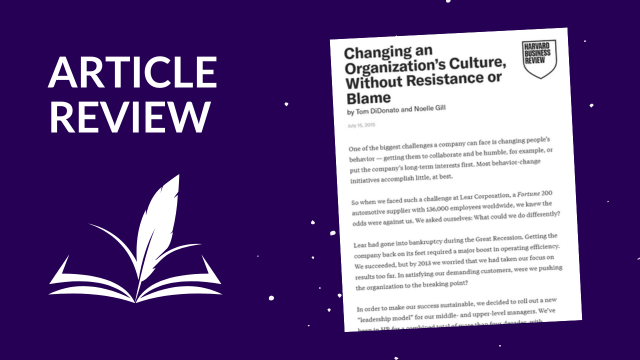In their article Changing an Organization’s Culture, Without Resistance or Blame, Tom DiDonato and Noelle Gill describe their approach to significantly shift the culture at Lear.
As they described it, they were working with a culture focused on efficiency and results.
While that focus had successfully moved the organization out of bankruptcy, “we worried that we had taken our focus on results too far. In satisfying our demanding customers, were we pushing the organization to the breaking point?”
The authors led a culture change focused on a new leadership model for middle- to upper-level managers.
Working with cohorts of 65 managers each, they executed the change in four phases.
- Awareness focused on getting the model out the Lear’s management. “We spent some money on publicity, including framed posters, mousepads, and even a sculpture commissioned for the headquarters lobby. The leadership model and related descriptions went out in the 20 languages used by Lear managers around the world.”
- Learning took place within each of three cohorts over a period of three months. Direct reports assessed each participant against the new model. The individuals, saw these assessments, but their supervisors did not. Each cohort then came together for a two-day retreat where they got to know the new model in detail. Importantly, peer groups of four managers from different locations worked together during the retreat and were encouraged to do so through the entire change process. Senior executives delivered a powerful message. “I’ll never forget our CEO, Matt Simoncini, getting up in front of dozens of managers and saying, in essence, ‘I’ve violated several of these model behaviors myself in the past. I’ve started to get better, but I still have a lot of work to do.’”
- Practice took place back in the workplace. Lear implemented quarterly reviews not attached to salary decisions; as a result, those reviews provided candid feedback without fear on the part of the manager being reviewed. They discussed any challenges the manager had applying the new behaviors and found ways to make the changes stick.
- Accountability took root at the six-month review. They completed individual assessments again, but this time both the individual manager and the supervisor read them. They took the results of that assessment into consideration regarding compensation, promotion, and even continued employment.
This approach applies much of what we know about moving people through change and was a success for Lear.
They recognized that behaviors don’t change overnight and put a process in place for peer coaching, support, and accountability.
The C-suite participated in the process – he message was “we are in this, and struggling with it, too.”
And they built accountability, with consequences, into the process.
That said, some things do stand out as either unaddressed in the article or unaddressed in the approach itself.
First, changing behavior without changing the thought process only works with ongoing monitoring over time.
As described, this model focused exclusively on behavior change.
In addition, while Lear’s review process was structured to occur quarterly, the kinds of conversations described in the article for the first review were effective if they occurred in an ongoing way.
Finally, even this process did not avoid resistance, as the authors claim in the title.
As they wrote,
“We did have to let several managers go, including some vice presidents.
We surfaced known troublemakers, at the extreme end of the spectrum, whom we’d previously turned a blind eye to because their results were good.
People had justified their rough leadership style by saying they had ‘passion,’ but over the years I’ve learned that’s just an excuse for bad behavior.
We couldn’t have them around while we pursued the program, or we would have lost our credibility.”
While Lear’s approach helped reduce resistance, it is an inevitable part of the human response to change and can, in fact, inform how to move forward more successfully.







